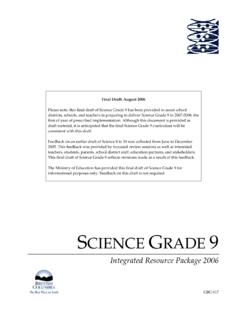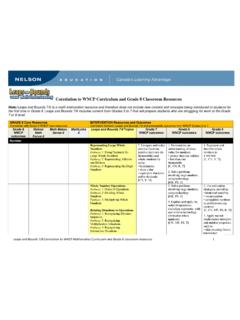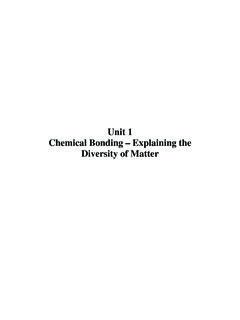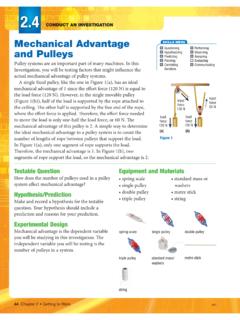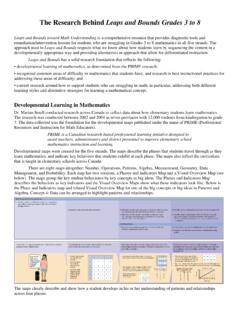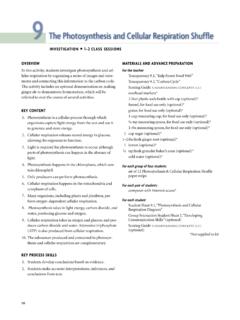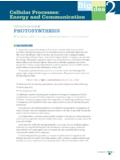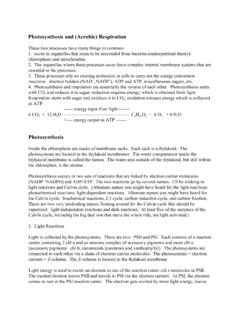Transcription of Unit 20C Photosynthesis and Cellular Respiration - …
1 Unit 20C Photosynthesis and Cellular Respiration 20 c20 CunitPhotosynthesis andCellular RespirationPhotosynthesis andCellular RespirationFor life to continue on Earth, two conditions must be met. First, matter must becontinuously cycled. With few exceptions, the number of atoms on Earth isunchanging. Although the atoms may be rearranged into new molecules, matter iscontinuously exchanged between plants, animals, fungi, and second condition for life on Earth is a supply of energy. Solar energy suppliesalmost all life on Earth. Plants are the key to keeping the energy flowing. These photo-autotrophs absorb carbon dioxide, water, and radiant energy from the environmentand, through Photosynthesis , transform these components into energy-rich sugars andoxygen gas. Then, through aerobic Respiration , they convert the energy stored in thesesugars and oxygen into the energy of , such as animals, fungi, and some protists, obtain nutrients fromtheir environment by eating plants, animals, or both.
2 Like plants, heterotrophs obtainenergy in the form of ATP by Cellular Respiration in which large food molecules arebroken down and carbon dioxide and water are returned to the environment. Inthis unit, you will investigate these transformations and exchanges of energy withinour living you progress through the unit, think about these focusing questions: How does light energy from the environment enter living systems? How is the energy from light used to synthesize organic matter? How is the energy in organic matter released for use by living systems? How do humans in their applications of technologies impact photosynthesisand Cellular Respiration ?174 Unit 20 CNELUNIT 20 C PERFORMANCE TASKS tudent AquaristEcosystems must maintain a delicate balance in order to remain healthy. How do factorssuch as temperature, light conditions, dissolved oxygen, and dissolved carbon dioxideaffect the metabolic health of the organisms within an ecosystem?
3 At the end of this unit,you may apply your skills and knowledge to complete this Performance 06_Bio_Alberta20 10/30/06 11:50 AM Page 174 Photosynthesis and Cellular Respiration175 NELUnit20 CGENERAL OUTCOMESIn this unit, you will relate Photosynthesis to storage ofenergy in compounds explain the role of Cellular Respiration inreleasing potential energy from organiccompoundsCh 06_Bio_Alberta20 10/30/06 11:50 AM Page 175 Unit 20 CPhotosynthesisand CellularRespirationARE YOU READY?176 Unit 20 CNELT hese questions will help you find out what you already know, and what you need toreview, before you continue with this Match the following names and functions to the labelled components of thecells in Figure 1(one name and one function per label).Names:cell membrane, nucleus, vacuole, mitochondrion, endoplasmic reticulum,Golgi apparatus, chloroplast, cell wall, flagellumFunctions:energy conversion, protein storage, protection, material transport withinthe cell, overall control, food production, water and nutrient storage, controlledentry and exit from cell, 2and 3show two processes that move materials into and out of cells.
4 (a) What process is represented by Figure 2? (b) What process is represented by Figure 3? (c) Name the structure labelled A in Figure 3.(d) What is the substance that passes through structure A in Figure 3? Concepts organisms, cells, tissues,organ systems Cellular structures andfunctions passive and active transportof matterSkills use instruments effectivelyand accurately for collectingdataYou can review prerequisiteconcepts and skills on theNelson Web site and in Unit Pre-Test is also available 1(a)A generalized animal cell; (b) A generalized plant cell(a)(b)AbeforeafterFigure 2 Figure 33. Compare passive transport by diffusion and osmosis with active transportin terms of (a) concentration gradients, (b) energy inputs, and (c) equilibrium and protein carrier 06_Bio_Alberta20 10/30/06 11:50 AM Page 176 Unit20 CPhotosynthesis and Cellular Respiration177 NEL4.
5 Match the following names to the labelled components of the leaf structure inFigure 4(one name per label).Names:epidermis, guard cells, palisade tissue, spongy tissue, phloem, xylem,vascular tissueABCDEGFF igure 4A typical leaf structureFigure 5A wet mount of onion cellsDBAFCEIGHKJF igure 6A compound light 5is a wet mount of onion cells viewed under medium power in acompound light microscope.(a) What might be the cause of the dark circles in Figure 5?(b) How could you avoid forming the circles?Skills6. Examine the following chemical equation:CH4 2 O2 CO2 H2 Omethaneoxygencarbon dioxidewaterWhich of the reactants is a compound? Provide reasons for your Match the following parts of the compound light microscope to the labels inFigure parts:arm, ocular lens, coarse-adjustment knob, stage,fine-adjustment knob, base, condenser, objective lens, revolving nosepiece,stage clips, light source8.
6 Place the following steps in the correct order for viewing a slide through acompound light microscope.(a) Rotate the nosepiece to the medium-power objective lens.(b) Use the fine-adjustment knob to bring the image into focus.(c) Place the slide on the stage and hold it in place with clips.(d) Use the coarse-adjustment knob to bring the low-power objective lens closeto the slide.(e) Make sure the low-power objective lens is in 06_Bio_Alberta20 10/30/06 11:51 AM Page 177In this chapter66 PhotosynthesischapterPhotosynthesisExplo ration: GlobalPhotosynthesis in ActionMini Investigation: Photosynthesis and LightInvestigation :Separating PlantPigments from LeavesCase Study: UsingSatellite and AirborneTechnology to MonitorPhotosynthesis andProductivityChemistry Connection: EnergyWeb Activity: Dr. RudolphArthur MarcusExplore an Issue:Harnessing Light EnergyInvestigation : HowDoes Carbon DioxideConcentration Affect theRate of Photosynthesis ?
7 Web Activity: FactorsAffecting PhotosynthesisPhotosynthesis is the process that converts energy from the Sun into chemical energy thatis used by living cells. Photosynthesis occurs in a variety of organisms, but most notablyin plants and certain groups of bacteria. The most obvious of these are the large landplants, but the world s oceans are also home to vast quantities of photosynthesizingmicroorganisms (Figure 1on the next page). All of these organisms convert carbondioxide, CO2(g), into organic molecules using the light energy captured by a human perspective, Photosynthesis is the most important large-scale chem-ical process on Earth. We are completely dependent on Photosynthesis for all the foodwe eat and the oxygen we breathe. In addition, all organic materials are constructed usingthe molecular building blocks and the energy supplied by Photosynthesis .
8 Therefore, wealso rely on Photosynthesis for things such as wood, paper, cotton, drugs, and fossil the human population grows and our rates of consumption grow, we becomeincreasingly dependent on vast quantities of Photosynthesis products. Recent estimatessuggest that humans now consume, either directly or indirectly, close to 40 % of the netprimary production of Earth s entire land surface. In other words, over one-third of theyearly production of all of Earth s terrestrial plants is used to meet human 6 NELA nswer these questions as best you can with your current knowledge. Then, using the concepts and skills you have learned, you will revise your answers at the end ofthe (a) Write the overall equation for Photosynthesis .(b) Do the O2molecules produced in Photosynthesis come from CO2or H2O or both?(c) What is the purpose of water in Photosynthesis ?
9 Are deciduous leaves green in the summer and yellow in the fall? does carbon fixationmean? process of Photosynthesis requires energy in the form of ATP. How do plantsobtain ATP for Photosynthesis ? are the processes of Photosynthesis and Cellular Respiration dependent on eachother?STARTING PointsCareer Connection: Nursery OperatorCh 06_Bio_Alberta20 10/30/06 11:51 AM Page 178 Photosynthesis179 NELE xplorationGlobal Photosynthesis in ActionEarth is a dynamic planet of land and water. The seasons areaccompanied by changing temperatures and levels of solarradiation factors that dramatically influence the distributionand activity of photosynthesizing organisms. Recent technological developments enable us to monitorsuch changes with great precision. In this Exploration, you willview an animation of biosphere data gathered over six years aspart of the Sea-viewing Wide Field-of-view Sensor (SeaWiFS)Project.
10 In the animation, areas of high plant life on land areshown in dark green, while areas of low plant life are shown intan. In the oceans, areas of high active Photosynthesis by phytoplankton are shown in red, and areas of lowest activity are shown in blue and purple (Figure 2).(a) Generate a hypothesis to describe the overall pattern youexpect to see on the land surface, and a hypothesis todescribe what you expect to see in the oceans. Where andwhen do you think land plants and marine phytoplanktonactivity will peak? (b) After recording your hypotheses, go to the Nelson Web siteand follow the links to view the animation sequence.(c) Describe the patterns of changes you see over the six-yearperiod.(d) Note any surprises you observe. Was Photosynthesis mostactive where you expected it to be?(e) Suggest possible explanations to account for the patternsyou witnessed on the land environment and in the 1 Photosynthesizing organisms live in oceans, lakes, streams, and rivers, as well as on land.


